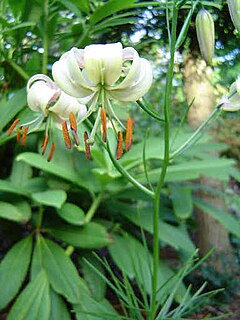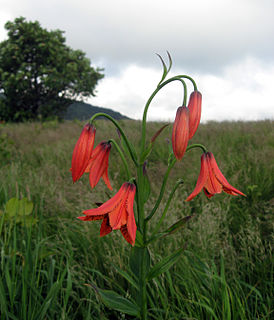
Lilium lancifolium is an Asian species of lily, native to China, Japan, Korea, and the Russian Far East. It is widely planted as an ornamental because of its showy orange-and-black flowers, and sporadically occurs as a garden escapee in North America, particularly the eastern United States including New England, and has made incursions into some southern states such as Georgia.

Lilium is a genus of herbaceous flowering plants growing from bulbs, all with large prominent flowers. They are the true lilies. Lilies are a group of flowering plants which are important in culture and literature in much of the world. Most species are native to the temperate northern hemisphere, though their range extends into the northern subtropics. Many other plants have "lily" in their common names, but do not belong to the same genus and are therefore not true lilies.

Lilium martagon, the martagon lily or Turk's cap lily, is a Eurasian species of lily. It has a widespread native region extending from Portugal east through Europe and Asia as far east as Mongolia.

Lilium ledebourii is a rare Asian species of plants in the lily family. It was named for German-Estonian botanist Carl Friedrich von Ledebour (1786-1851). Its native range is the Talish region of Azerbaijan, and Damasch in the Amarlu region of Iran.

Hemerocallis fulva, the orange day-lily, tawny daylily, corn lily, tiger daylily, fulvous daylily, ditch lily or Fourth of July lily, is a species of daylily native to Asia. It is very widely grown as an ornamental plant in temperate climates for its showy flowers and ease of cultivation. It is not a true lily in the genus Lilium, but gets its name from the superficial similarity of its flowers to Lilium and from the fact that each flower lasts only one day.

Lilium kelleyanum is a California species of lily known by the common name Kelley's lily. It grows primarily in wetlands in the Sierra Nevada as well as in the Coast Ranges and southern Cascades in the northern part of the state.

Lilium pumilum is an Asian species of bulbous plants native to Mongolia, Siberia, the Russian Far East, Korea and northern China.

Lilium cernuum is a species of lily native to Korea, the Primorye region of Russia, and northeastern China.

Lilium pensylvanicum is an Asian plant species of the family Liliaceae. Sometimes called the Siberian lily, it is native to a cold climate and needs frost in the winter. It is found in the wild form in Siberia, the Russian Far East, Mongolia, northeast China, Korea and Hokkaidō.

Lilium tsingtauense, also known as twilight lily, is an East Asian species of plants in the lily family. It is native to Korea and eastern China.

Lilium medeoloides is an East Asian herb in the lily family. It is native to Zhejiang Province in China, Jeju-do in Korea, and eastern Russia, where it grows in forests and on grassy and rocky subalpine areas.

Lilium grayi is a perennial plant that is endemic to the eastern US states of North Carolina, Virginia, and Tennessee, growing in moist, acid soil in the Appalachian mountains on higher elevation meadows, bogs, and seeps. The plant was introduced to Royal Botanic Gardens, Kew in 1890 and was featured in the Kew Bulletin in 1892.

Lilium iridollae is a species of Lilium or lily. It is a perennial forb. This species is considered one of five known Lilium species native to specific sites in the United States' southeast region. In 1940, this species was discovered by Mary Henry in its habitat. She named the lily in reference to a "pot of gold at the end of the rainbow".

Lilium hansonii, known as Hanson's lily and Japanese turk's-cap lily, is an East Asian species of plants in the lily family. It is native to Korea, Japan, and to Jilin Province in northeastern China, as well as being widely cultivated as an ornamental.

Lilium pyrophilum, the sandhills lily, is a North American species of plant in the lily family. It is endemic to the Sandhills region of southern Virginia, North Carolina and northern South Carolina, in the eastern United States.

Lilium fargesii is a Chinese species of plants in the lily family native to Hubei, Shaanxi, Sichuan and Yunnan provinces of China.

Lilium concolor is a species of flowering plant in the lily family which occurs naturally in China, Japan, Korea and Russia. Its relationship with other species is not clear, although it has some similarities to Lilium pumilum.

Iris potaninii is a species in the genus Iris, it is also in the subgenus of Iris and in the Psammiris section. It is a rhizomatous perennial, from Siberia in Russia, Mongolia and China. It is a dwarf plant, having either subterranean or very small stems, long thin leaves and yellow, or dark violet to purplish blue flowers. It is cultivated as an ornamental plant in temperate regions.

Iris dichotoma is a species in the genus Iris and is also in the subgenus of Iris. It was once formerly known as Pardanthopsis dichotoma as it was placed as genus species on its own before dna testing resulted in it returning to the irises section. It is native to the forests and grasslands of Siberia, China, Mongolia and Korea. It has long greyish green leaves, long branched stems carrying many flowers in summer or late summer. In shades of violet, mauve to purple, lavender, pale blue, white or pink. They appear in the late afternoon at the time of Vespers.

Lilium polyphyllum is a species of lily endemic to montane environments in central Asia.




















